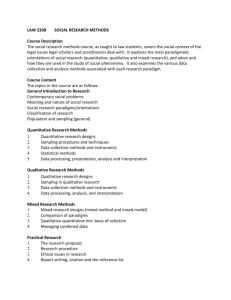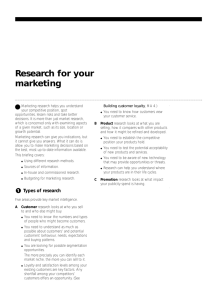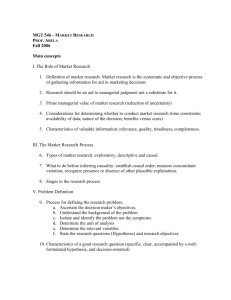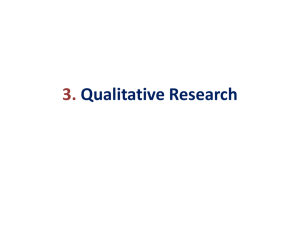Consumers Rule
advertisement
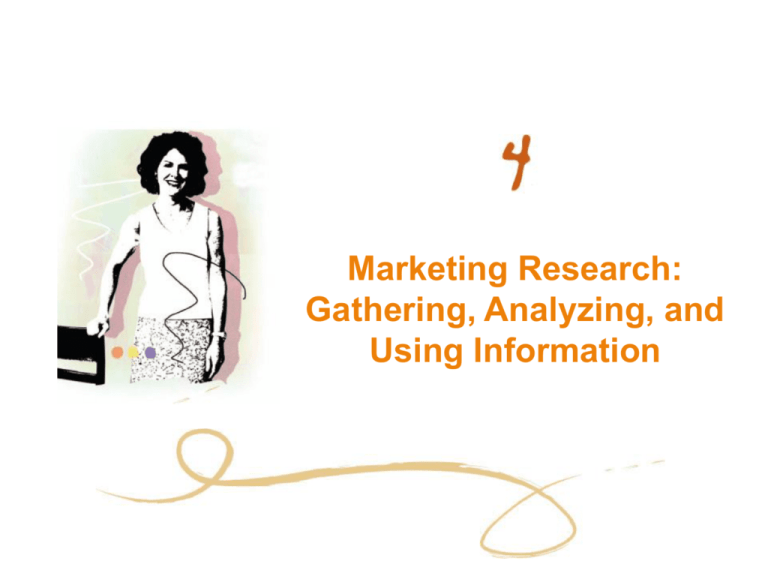
Marketing Research: Gathering, Analyzing, and Using Information Chapter Objectives • Explain the role of the marketing information system and the marketing decision support system in marketing decision making • List and explain the steps in the marketing research process • Appreciate the differences among exploratory, descriptive, and casual research • Describe the different types of data-collection methods and types of consumer samples that research use • Understand the impact of the growing use of online research 2 Real People, Real Choices • Meet Cindy Turgate at Plan-it Marketing, a marketing research firm • Priceline needed help in planning its business. Would its name-your-own-price strategy fly? • The decision: What marketing research strategy would maximize results within a reasonable budget? Option 1: conduct exploratory qualitative study Option 2: conduct quantitative survey of 700+ leisure and business travelers Option 3: conduct viability study with both qualitative exploratory study and confirmatory quantitative study 3 Knowledge is Power • Accurate, up-to-date, relevant information is the fuel that runs the marketing engine 4 The Marketing Information System • Determines what information marketing managers need, then gathers, sorts, analyzes, stores, and distributes information to system users 5 Internal Company Data • Information from within the company to produce reports on the results of sales and marketing activities • Intranet: internal corporate communications network that links company departments, employees, and databases. 6 Marketing Intelligence • Monitoring everyday sources and using “mystery shoppers” • Futurists specialize in predicting consumer trends 7 Marketing Research • Collecting, analyzing, and interpreting data about customers, competitors, and the business environment to improve marketing effectiveness Syndicated research Custom research 8 Acquired Databases • From other companies • Government databases • Misuse of databases can be problematic and has led to do-not-call lists and antispam laws 9 Marketing Decision Support Systems • MDSS: data plus analysis and interactive software allow marketing managers to access MIS data and conduct analyses 10 Searching for Gold: Data Mining • Analysts sift through data to identify unique patterns of behavior among different customer groups 11 What Marketers Can Do with Data Mining • • • • Customer acquisition Customer retention and loyalty Customer abandonment Market basket analysis 12 Steps in the Marketing Research Process • Step 1: Define the research problem Specifying research objectives Identifying consumer population of interest Placing the problem in an environmental context • Step 2: Determine the Research Design Specifying exactly what information marketers will collect and what type of study they will do 13 Figure 4.5: Marketing Research Design 14 Secondary Versus Primary Research • Secondary data have been collected for some purposes other than the problem at hand • Primary data is information collected directly from respondents to specifically address the question at hand 15 Exploratory (Qualitative) Research • Research techniques that generate insights for future, more rigorous studies • Researchers conduct one-on-one discussions with consumers • Focus group: a product-oriented discussion among a small group of consumers 16 Exploratory (Qualitative) Research (cont’d) • Projective techniques: participants respond to some object • Case study: comprehensive examination of a particular firm • Ethnography: Marketers visit homes or participate in consumer activities to learn how products are used 17 Descriptive (Quantitative) Research • Probes systematically into the problem • Bases conclusions on large numbers of observations • Results typically expressed in quantitative terms (averages, percentages, other stats) Cross-sectional design Longitudinal design 18 Causal Research • Cause-and-effect relationships: a change in one thing causes a change in something else Independent (cause) vs. dependent (change in outcome) variables Experiments: test predicted relationships among variables in a controlled environment 19 Steps in the Marketing Research Process (cont’d) • Step 3: Choose the Method for Collecting Primary Data Survey Methods: interview respondents Questionnaires: loosely, moderately, or completely structured 20 Questionnaires • • • • Mail questionnaires Telephone interviews Face-to-face interviews Online questionnaires 21 Observational Methods • Observation: data collection where the researcher records consumers’ behaviors, often without their knowledge Personal observation Mechanical observation Unobtrusive measures 22 Data Quality: Garbage In, Garbage Out • How much faith should marketing managers place in research? Validity Reliability Representativeness 23 Online Research • Information gathered via consumer surfing and Web site/email/chat room questionnaires/focus groups • Cookies allow a Web sponsor to track a surfer’s moves 24 Online Research Applications • • • • New product development Estimating market response Exploratory research (online focus groups) IM (Instant Messaging) 25 Advantages of Online Data Collection • The same amount of data in a fraction of the time • Convenience of survey completion • Elimination of interviewer bias and data entry errors 26 Disadvantages of Online Data Collection • Non-representativeness of respondents • Limited computer access for poor and elderly • Self-selection bias (people who like to take part in online studies) • Hackers and competitors influencing/intercepting results 27 Step 4: Design the Sample • Probability sample • Each member of the population has some known chance of being included • Sample is representative of population, and inferences about population are justified • - Simple random sampling *Christine: these three should be lower-level (black)* • - Systematic sampling • - Stratified sampling 28 Step 4: Design the Sample (cont’d) • Nonprobability sample • Personal judgment used in selecting respondents • Some members of population have no chance of being included • No way to ensure that sample is representative of population Convenience sampling Quota sampling 29 Step 5: Collect the Data • Challenges to gathering data in foreign countries Differences in sophistication of research operations Infrastructure/transportation challenges Lack of phones Low literacy rates Local customs and cultural differences Language translation difficulties 30 Step 6: Analyze and Interpret the Data • Data need analysis for them to have meaning • Tabulation: arranging data in a table or other summary form to get a broad picture of overall responses • Cross-tabulation: examining the data by subgroups to see how results vary between categories 31 Step 7: Prepare the Research Report • Executive summary • Description of research methodology • Discussion of results including tabulations, cross-tabulations • Limitations of study • Conclusions and recommendations 32 Real People, Real Choices • Plan-it Marketing (Cindy Turgate) • Cindy chose option 3: conduct viability study with both qualitative exploratory study and confirmatory quantitative study Priceline.com was launched nationally in April 1998, and it continues to flourish 33 Keeping It Real: Fast Forward to Next Class Decision Time at Wild Planet • Meet Danny Grossman, CEO and founder of Wild Planet Toys. • Room Gear: a product line that lets kids decorate their rooms met with sharply different gender appeals • The decision: the future direction of the Room Gear line 34



